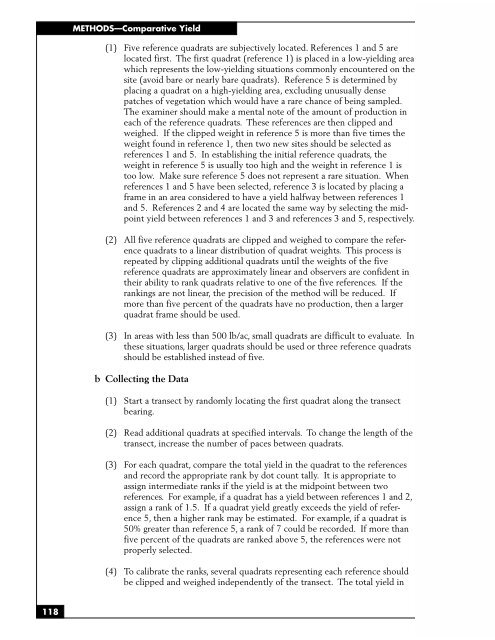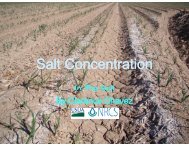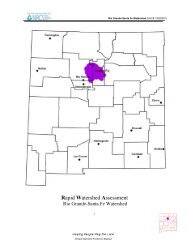SAMPLING VEGETATION ATTRIBUTES - New Mexico NRCS - US ...
SAMPLING VEGETATION ATTRIBUTES - New Mexico NRCS - US ...
SAMPLING VEGETATION ATTRIBUTES - New Mexico NRCS - US ...
You also want an ePaper? Increase the reach of your titles
YUMPU automatically turns print PDFs into web optimized ePapers that Google loves.
118<br />
METHODS—Comparative Yield<br />
(1) Five reference quadrats are subjectively located. References 1 and 5 are<br />
located first. The first quadrat (reference 1) is placed in a low-yielding area<br />
which represents the low-yielding situations commonly encountered on the<br />
site (avoid bare or nearly bare quadrats). Reference 5 is determined by<br />
placing a quadrat on a high-yielding area, excluding unusually dense<br />
patches of vegetation which would have a rare chance of being sampled.<br />
The examiner should make a mental note of the amount of production in<br />
each of the reference quadrats. These references are then clipped and<br />
weighed. If the clipped weight in reference 5 is more than five times the<br />
weight found in reference 1, then two new sites should be selected as<br />
references 1 and 5. In establishing the initial reference quadrats, the<br />
weight in reference 5 is usually too high and the weight in reference 1 is<br />
too low. Make sure reference 5 does not represent a rare situation. When<br />
references 1 and 5 have been selected, reference 3 is located by placing a<br />
frame in an area considered to have a yield halfway between references 1<br />
and 5. References 2 and 4 are located the same way by selecting the midpoint<br />
yield between references 1 and 3 and references 3 and 5, respectively.<br />
(2) All five reference quadrats are clipped and weighed to compare the reference<br />
quadrats to a linear distribution of quadrat weights. This process is<br />
repeated by clipping additional quadrats until the weights of the five<br />
reference quadrats are approximately linear and observers are confident in<br />
their ability to rank quadrats relative to one of the five references. If the<br />
rankings are not linear, the precision of the method will be reduced. If<br />
more than five percent of the quadrats have no production, then a larger<br />
quadrat frame should be used.<br />
(3) In areas with less than 500 lb/ac, small quadrats are difficult to evaluate. In<br />
these situations, larger quadrats should be used or three reference quadrats<br />
should be established instead of five.<br />
b Collecting the Data<br />
(1) Start a transect by randomly locating the first quadrat along the transect<br />
bearing.<br />
(2) Read additional quadrats at specified intervals. To change the length of the<br />
transect, increase the number of paces between quadrats.<br />
(3) For each quadrat, compare the total yield in the quadrat to the references<br />
and record the appropriate rank by dot count tally. It is appropriate to<br />
assign intermediate ranks if the yield is at the midpoint between two<br />
references. For example, if a quadrat has a yield between references 1 and 2,<br />
assign a rank of 1.5. If a quadrat yield greatly exceeds the yield of reference<br />
5, then a higher rank may be estimated. For example, if a quadrat is<br />
50% greater than reference 5, a rank of 7 could be recorded. If more than<br />
five percent of the quadrats are ranked above 5, the references were not<br />
properly selected.<br />
(4) To calibrate the ranks, several quadrats representing each reference should<br />
be clipped and weighed independently of the transect. The total yield in




